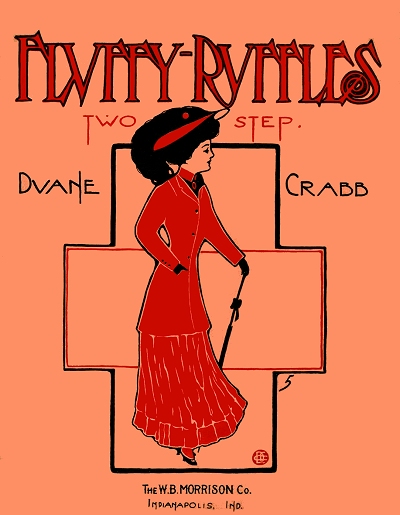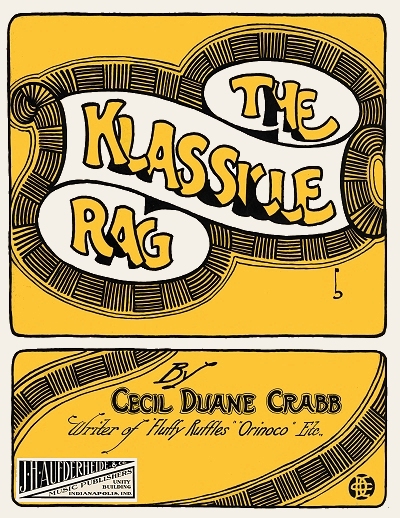Cecil Duane Crabb, or "Cece" as some of his peers called him, was part of the Indianapolis group of young composer friends who contributed just a few but still significant pieces into the ragtime collective. He was the youngest of four children born in Indiana to James Newton Crabb and his wife Sarah Elizabeth Myers, the others being Viola (1874), Nora (1875) and Earl (1/1884). After several years of struggling to get by in Centerville, the family had moved westward to Indianapolis by 1900 where Cecil's older brother Earl, now 16, worked as a clerk in a phonograph store, and their father was a canvasser or poll taker and a travel agent. James was also an inventor with several interesting patents issued to him dating back to the 1870s. By the age of 18 Cece was evidently not living with his parents in Indianapolis.
James was also an inventor with several interesting patents issued to him dating back to the 1870s. By the age of 18 Cece was evidently not living with his parents in Indianapolis.
 James was also an inventor with several interesting patents issued to him dating back to the 1870s. By the age of 18 Cece was evidently not living with his parents in Indianapolis.
James was also an inventor with several interesting patents issued to him dating back to the 1870s. By the age of 18 Cece was evidently not living with his parents in Indianapolis.After a roller-skating accident Cece was taken in for a time by Mr. E.D. Staley and his wife. The Staleys discovered in short order his propensity for both piano and graphic arts. In an effort to provide stability and a positive direction for Crabb, Mr. Staley set him up in a sign-making shop, producing outdoor and on door signs for businesses.
During this time Cece befriended May Aufderheide, fresh out of finishing school, and quickly helped her to get her Dusty Rag into print, something she was trying to do over her father's objections. Another new acquaintance, composer Paul Pratt, arranged the piece and Cecil did the cover art. It was the only piece published by the Duane Crabb Publishing Company. Because of May's determination to have her work in print, her father, John Henry Aufderheide, admired the efforts of the teenaged trio to the point where he started J.H. Aufderheide & Company just to publish their works, and Cece was also rewarded for his efforts in helping her.
Although Crabb was retained for cover artwork, possibly even having designed the distinctive logo, he also published a few pieces with the firm. The first of these was Fluffy Ruffles, one of a number of ragtime era pieces with this name. He had composed it in 1907 and another Indianapolis composer, Will Morrison, helped him publish it. It was quickly picked up by J.H. Aufderheide for his new company, but was preceded by Crabb's latest rag in 1909, Orinoco. That same year Cecil co-wrote the piece Trouble with Morrison. He also contributed artwork for some of the Aufderheide rags, including Candle-Stick by Abe Olman and A Totally Different Rag by May. Pratt, who like Cecil was not yet 20, was hired as the manager and arranger for the Aufderheide company, as shown in the 1910 enumeration.
By that time, Cecil was once again living with his parents, his occupation listed as sign painter, music being a sideline to work which brought in needed income. Pratt later recalled that even though there had been no historical confirmation of contracts for those published by Aufderheide, he received a 1.5 cent per copy royalty for this piece, so the same was likely true for Cecil. This would also include his Klassicle Rag, perhaps a nod or even a swipe at the genre of "Classic Ragtime" which was fairly well known by 1911.
This would also include his Klassicle Rag, perhaps a nod or even a swipe at the genre of "Classic Ragtime" which was fairly well known by 1911.
 This would also include his Klassicle Rag, perhaps a nod or even a swipe at the genre of "Classic Ragtime" which was fairly well known by 1911.
This would also include his Klassicle Rag, perhaps a nod or even a swipe at the genre of "Classic Ragtime" which was fairly well known by 1911.The success of the firm from publicity, as well as additional composers in the stable like Morrison, Olman, Gladys Yelvington and Julia Lee Niebergall, allowed John Aufderheide to expand his enterprise with a second location in a better distribution hub; Chicago, Illinois. He sent Pratt there to manage the new branch, with Niebergall taking over some of the arranging duties in Indianapolis. Unfortunately for all involved in the expanding company, fortunes quickly dried up. May lost her desire to continue on track with her well-crafted rags, and with sales suddenly slowing, her father also lost interest in continuing the company. His sale of the J.H. Aufderheide catalog to the Mentel Brothers in Cincinnati left Pratt in Chicago without a job and Cecil without his friends close by.
Cecil was married to his first wife Ethelene Griffing on December 5, 1912, and they welcomed their daughter Jane into the world on February 23, 1914. On his 1917 draft record, Cecil indicated his occupation again as sign painter for the Staley and Pratt Sign Company, and listed construction as well. The 1920 census showed the family living in Indianapolis, and Cecil as a proprietor, as he was still in business for himself. He was also engaged in light graphic arts, and even started an early outdoor advertising firm. In the early 1920s Cecil and Ethelene went their separate ways, and he was soon remarried to Stella Seidensticker. Together they had a daughter and two sons, Rosalyn (12/8/1925), James M. (2/1927) and Cecil, Jr. (1/17/1929). Business in outdoor advertising must have been fairly good as their busy household had a maid according to the 1930 enumeration. Sarah would die on April 16, 1936.
At some point in the subsequent decade Cece went into the florist business, owning a shop on Monument Place in Indianapolis for many years. As of the 1940 census, taken in Indianapolis, he was widowed and living with his daughter Rosalyn and sons James and Cecil, Jr., plus his mother-in-law Margaret Seidensticker. His occupation was as the "executor" of a flower shop. In his later life he also enjoyed fishing, and playing ragtime for grateful friends and fans, seeming to be perfectly happy for his brief flash of fame in Indianapolis. Having moved northward in 1951, Cecil Crabb died in Rice Lake, Wisconsin, just short of 63 years old.
 Compositions
Compositions